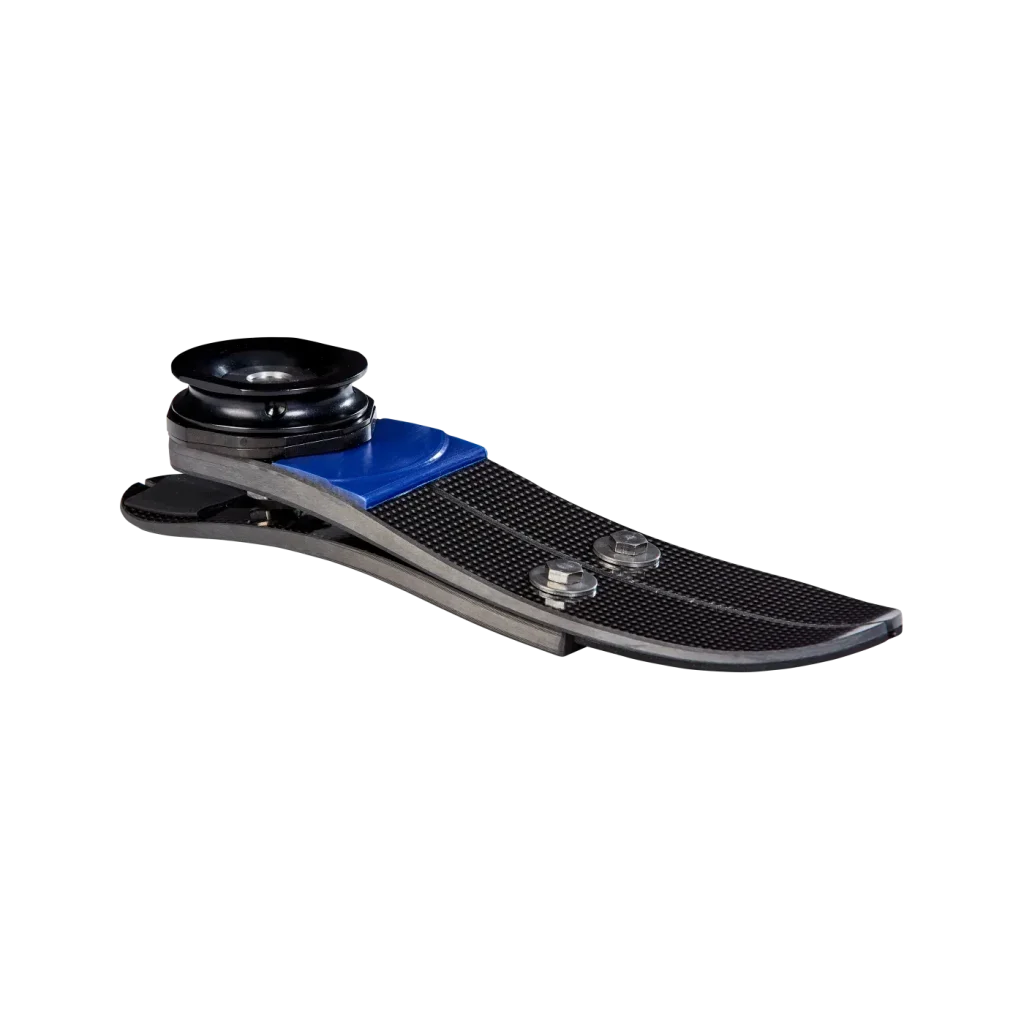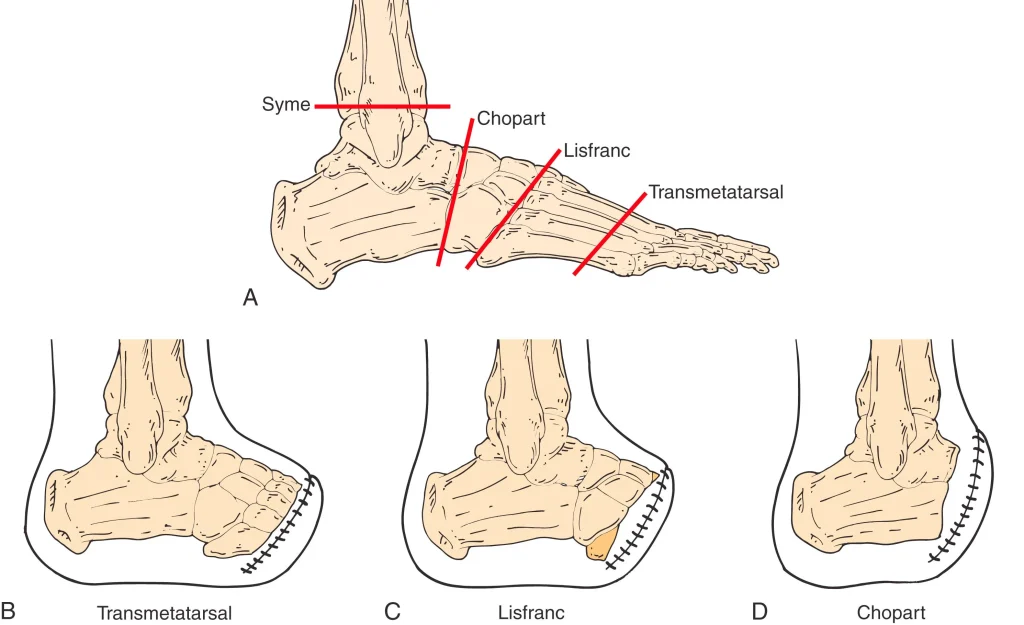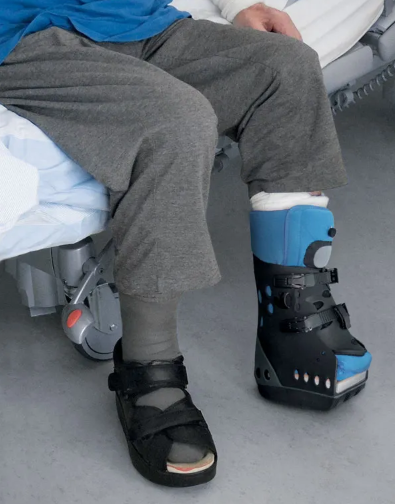
It is natural to feel apprehensive at the thought of an amputation. But it also marks the opening of a new chapter where independence and a fulfilling life become possible. When exploring your options, the Syme amputation is a unique and often highly advantageous path forward.
This blog will delve into the Syme amputation procedure, the prosthetic solutions available, and how this Syme prosthesis can empower individuals to step forward and confidently embrace a brighter future.
What is a Syme’s Amputation?
Syme’s amputation, also known as ankle disarticulation, is a partial foot amputation performed through the ankle joint. Named after 19th-century Scottish surgeon James Syme, the procedure removes the foot and malleoli while preserving the heel pad, which is then anchored under the tibia and fibula to create a weight-bearing stump. It is different from above- and below-knee amputations and other partial foot levels, like Lisfranc and Chopart.
The three major partial foot amputation types are:
- Lisfranc (midfoot)
- Chopart (through the midtarsal)
- Syme’s (ankle joint)
Lisfranc, Chopart & Syme’s: Amputation Levels & Prosthetics
Level of Amputation Definition Weight Bearing Prosthetic Options (Economy → Premium)
| Level of Amputation | Amputation Site | Weight Bearing | Prosthetic Options (Economy → Premium) |
|---|---|---|---|
| Lisfranc | Forefoot | No | AFO filler, rocker insole, simple footplate |
| Chopart | Midfoot | Minimal | Shoe insert, Össur Chopart plate |
| Syme’s | Ankle (heel pad retained) | Intermittent without prosthesis | Basic Syme foot → Össur Pro-Flex Symes |
As the highest partial-foot amputation before below-knee, Syme’s preserves more limb length and proprioception than Chopart or transmetatarsal amputations (a surgical procedure where the forefoot, including the metatarsal bones, is removed), enabling better gait efficiency with less energy cost.
Common Reasons for Syme’s Amputation
Typical indications include:
Severe foot/ankle trauma (crush injuries): Crush injuries are the outcome of severe compression over the foot or Ankle, including the force of objects which may fall on the foot and accidents involving vehicles or machinery.
Infections: Osteomyelitis is a severe bone infection that progresses from diabetic foot ulcers, often leading to foot amputation.
Congenital deformities: These are present from birth, such as structural abnormalities. The abnormalities may include an abnormal foot and Ankle position or limb differences.
Neuroarthropathy: This condition, called Charcot joint, destroys the foot and ankle joints. It is a progressive and painful disease that gradually degenerates the bones, cartilage, and soft tissues.
Peripheral vascular disease: A progressive narrowing or spasms in a blood vessel. The circulation disorder attacks the legs and feet, creating pain, numbness, and other painful symptoms.
Tumours (sarcomas): Malignant tumours develop in bones, cartilage, fat, muscle, and blood vessels. They may appear as lumps or swellings with or without pain.
In certain cases, especially with infections, a staged procedure is done: first, ankle disarticulation, then removal of malleoli and soft tissue revision after 6 weeks.
What Is A Syme Prosthesis?
The Syme prosthesis is a customised limb that improves the unique benefits of a Syme amputation. Its goal is to restore almost natural mobility, provide stable limb movement, and allow individuals to walk comfortably.
Core Components of a Symes Prosthesis
Each Syme prosthesis is custom-made, integrating several key parts
- Socket: Attaches to the residual limb for weight distribution and comfort.
- Suspension: Holds the prosthesis in place securely.
- Total Contact: Even pressure distribution.
- Suspension Sleeve: Vacuum or friction-based fit.
- Prosthetic Foot: Mimics natural motion and stores/releases energy for easier walking.
- Liners & Padding: Offer cushioning and protect skin integrity
How Does Rehabilitation Help to Use A Syme Prosthesis?
Rehabilitation helps recover after a Syme amputation and learning to use a prosthesis:
Post Surgery Care
Once surgery is complete, stump management will be the focus. The attention now is on keeping the area clean, bandaged, and healing.
Clinicians and medical care personnel show you how to compress using elastic bandages or a shrinker sock to minimise swelling and ensure successful prosthetic fitting.
Prosthetic Fitting Timeline
The timeline for fitting your prosthesis may vary from weeks to months. Fitting begins after your wound heals. Prosthetists at KARE collaborate with clinicians to determine the ideal time for the fitting process.
Rehabilitation Focus
Rehabilitation focuses on several key areas to help you regain function and confidence:
- Stump Care and Desensitisation: The KARE team teaches you to properly care for your residual limb, including cleaning and skin care.
- Desensitisation: This includes rubbing, tapping, or placing cloths or sponges on the stump, which reduces sensitivity and phantom sensations.
Prosthetic & Orthotic Solutions for Foot Amputations
Prosthetic solutions for all partial-foot amputations range from simple shoe insoles to AFOs and foot‑ankle orthoses, customised on the residual limb and activity requirements.
Partial Foot & Transmetatarsal-Level Prosthetics
- AFO + filler: Adds build height in conventional footwear.
- Insole filler: Cushioned inserts for comfort and limb length compensation.
- Insole with carbon footplate: Adds rigidity and energy return.
- Blue rocker sole: Simulates toe-off for efficient gait.
Syme’s Prosthesis Options
Basic: Bare Syme foot with rocker sole
Premium: Össur Pro-Flex Symes (carbon fiber, energy storing, waterproof)
Chopart Level Feet
Economic: Regenesis foot plate
Premium: Chopart Össur carbon footplate
Have questions or need support?
Contact our team to book a consultation or ask about Syme’s prosthetic options. We’re here to help you move forward with confidence.

How KARE Supports Your Recovery After Syme Amputation
KARE Prosthetics & Orthotics provides holistic care from assessment to fitting and aftercare.
Initial Assessment
We begin the assessment by evaluating the residual skin and healing progress, examining the vascular status, and critically examining the limb length. After understanding your pain points, our team starts working on finding the most suitable solution for you.
Custom Socket Design
The KARE team uses split-casting or integrates flexible liners for bulbous limbs. The split-casting method creates a socket with a removable section, making putting on and removing the prosthesis easy and comfortable. Flexible liners of quality materials provide a relaxed, cushioned touchpoint that adapts to the limb’s specific contours, accommodating natural fluctuations.
Build Height Allocation: At KARE, “Build Height Allocation” is about precisely selecting and combining prosthetic foot components (like a “Blue Rocker” or “AFO filler”) and custom socket depth. It ensures the entire prosthesis is aligned to offer comfort, natural movement, and proper pressure distribution.
Prosthetic Foot Selection
We provide multiple foot solutions suitable for your requirements and budget-friendly:
Trial & Gait Training
Limb Length Discrepancy: Sometimes, the length of the prosthetic limb is a problem. Your prosthetist will work to minimise this discrepancy by designing your custom prosthesis, ensuring a balanced gait.
Prosthetic alignment is the critical process of perfectly setting up your artificial limb. It involves adjusting all the components from the socket to the foot to ensure proper balance, efficient walking and comfort.
Gait Training with the Prosthesis: It is where you learn to walk with your new Syme prosthesis with the help of a physical therapist who will guide you through exercises to develop a smooth, efficient, and natural walking pattern. It progresses from:
- Parallel Bar Walking: Using parallel bars for support.
- Crutch/Cane Walking: Progressing to assistive devices.
- Weight Shifting Exercises: Practising shifting weight from side to side.
- Step-Over Obstacles: Learning to clear small objects.
Rehabilitation & Education
Rehabilitation focuses on several key areas to help you regain function and confidence:
Stump Care and Desensitisation: We teach you to take good care of your residual limb, including cleaning and inspecting the skin.
Training for putting on and taking off your prosthesis: It is essential to learn the correct way of putting on and taking off the prosthetic limb. At KARE, we teach you easy, safe methods specific to your prosthesis, including weight bearing with the heel pad of your new leg to feel comfortable and stable.
Follow up Care
- Monitoring fit: The wider ankle area of a Syme residual limb can sometimes make achieving the slimmest possible prosthetic ankle profile challenging; however, the skilled prosthetists at KARE design perfect solutions to address such problems.
- Pressure distribution: KARE ensures comfortable liners and soft paddings or protective barriers to prevent skin irritation and other issues on the residual limb and provide even pressure distribution.
- Footwear advice: Our after-sales support and advice ensure you feel confident managing your prosthesis.
At KARE, clients get custom-fit craftsmanship, the complete spectrum of components, and ongoing support. Thus, they are sure of optimal functional and cosmetic outcomes.
FAQs About Syme’s Amputation and Recovery
It preserves more limb length and often improves gait efficiency.
Healing varies by individual; prosthetic fitting may start within weeks to months.
Options vary by budget. Össur Pro-Flex Symes is a premium, energy-efficient choice.
Yes, with proper rehabilitation and prosthesis fitting.
KARE Prosthetics & Orthotics offers complete care from assessment to aftercare.
Conclusion
Syme’s amputation is a powerful option that balances limb preservation with functional prosthetic solutions. Technological advancements provide mobility to individuals who have lost a limb or have other issues. They can easily regain their comfort and confidence by wearing simple insole fillers or premium carbon-fibre feet such as Össur’s Pro-Flex Symes.
The KARE Prosthetics & Orthotics team ensures individualised care from healing to Rehabilitation so you can step forward with confidence, strength, and dignity.
For consultations and foot assessments, contact KARE. We’re here to help guide you through every step.





